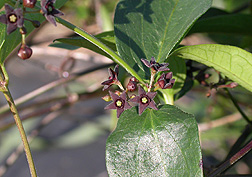This page has been archived and is being provided for reference purposes only. The page is no longer being updated, and therefore, links on the page may be invalid.
| Read the magazine story to find out more. |
|
|
Searching for Ways to Control an Agricultural Nuisance
By Dennis O'BrienSeptember 5, 2013
U.S. Department of Agriculture (USDA) scientists are working with partners overseas to curb the threat two weed species pose to nurseries, Christmas tree farms, pastures, and wildlife habitats.
Known as "dog-strangling vines" in Canada, European swallow-worts are invasive vines that can grow to eight feet in length and wrap around supporting vegetation and smother it. There are two species, pale swallow-wort (Vincetoxicum rossicum) and black swallow-wort (V. nigrum). Both have pushed onto pastures and are encroaching on the habitats of threatened and endangered species in New England and New York. The weeds have also invaded distinctive prairie-like vegetation around the Great Lakes.
Lindsey Milbrath, an Agricultural Research Service (ARS) entomologist in Ithaca, N.Y., is working with ARS and university colleagues in Ithaca, Urbana, Ill., and Frederick, Md., and overseas partners on ways to control the vines. ARS is USDA's principal intramural scientific research agency.
The researchers are evaluating beetles, moths and fungi as potential biocontrols, and are searching for the biological mechanisms that make the swallow-worts such serious threats. They are also tracking the progress of swallow-wort populations in New York, and studying their habitats and life cycles to see if there are life cycle stages when they are particularly vulnerable.
They have narrowed down the list of potential biocontrols to two fungi and two moths that, as caterpillars, feed on related species of swallow-worts. One of the moths, Abrostola clarissa, was found in Russia with the aid of collaborators at the Zoological Institute in St. Petersburg. The other moth, A. asclepiadis, was collected in France with help from collaborators at the ARS European Biological Control Laboratory in Montpellier.
Finding an effective biocontrol can be a challenge. Researchers often find shortcomings in candidates. When they find one they think will work, they must clear a number of regulatory hurdles designed to prevent releases that could cause more harm than good. Release of any biocontrols is likely still a few years away, but Milbrath is confident that the efforts will pay off.
Read more about this research in the September 2013 issue of Agricultural Research magazine.

